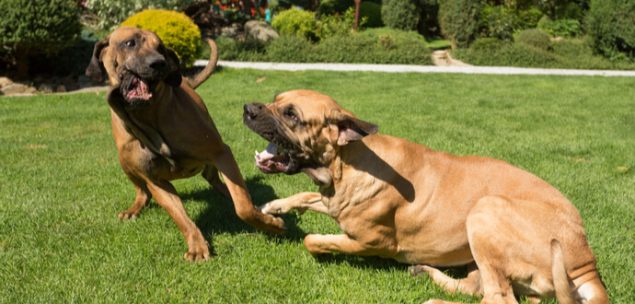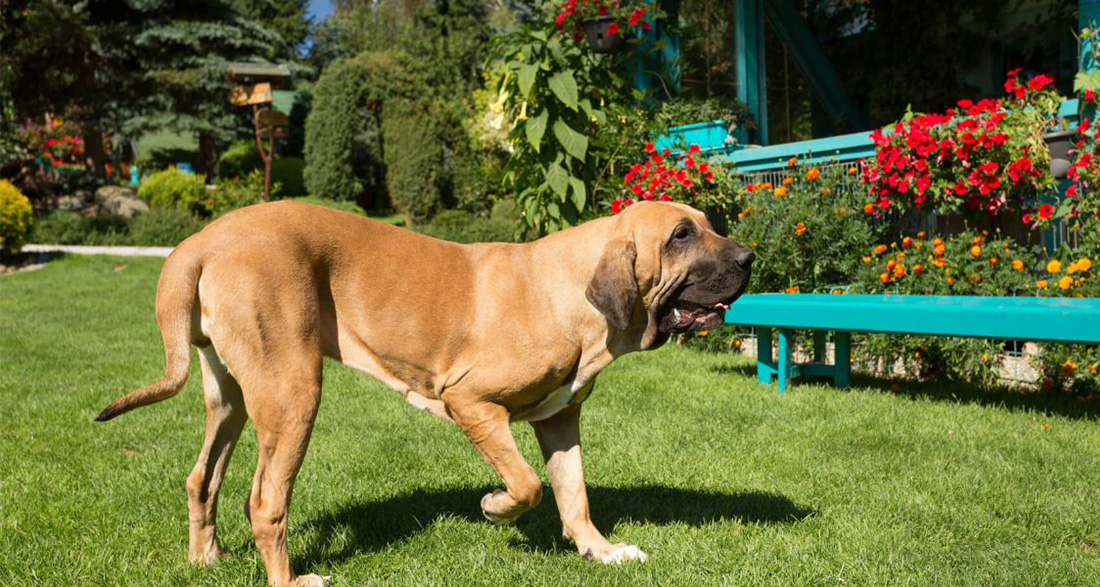The Fila Brasileiro is not only a powerful guard dog but also a popular hunting dog in South America. As a so-called “restricted breed,” it belongs to a dog breed that suffers from many prejudices. However, it can be well trained and is a real cuddle bear at home.
History of the Fila Brasileiro
The Fila Brasileiro is a large Brazilian dog, whose origin story cannot be fully traced to this day. It is assumed that the Fila originated from a crossbreeding of various Molossers (massive dog types) and Bloodhounds. Clarity about the ancestors of these dogs can only come from a detailed breakdown of their genes.
It is documented, however, that the Fila Brasileiro was an excellent guard and hunter. Additionally, it herded cattle or other large livestock and was a lively escape deterrent during Brazilian slavery.
In 1946, the initial guidelines for the Fila Brasileiro breed were established. The responsibility of maintaining breeding records was assigned to the residents of Sao Paulo. By 1954, the Brasil Kennel Club (BKC) officially recognized the breed, followed by the Fédération Cynologique Internationale (FCI) in 1960. However, despite its acceptance by international organizations, the Fila Brasileiro is not acknowledged by show clubs such as the American Kennel Club.
Systematic breeding according to standardized criteria only began in 1947, which means that the Fila – as we know it today – is still a very young dog breed.
Its reliable work in hunting, on plantations, and on the farm was the focus for a long time. In the 1970s, the functional connection slowly dissolved. Nowadays, the Fila is not only a courageous protector but also a lovable family friend.
Breed Overview
GROUP: Herding
HEIGHT: 26 to 30 inches (males); 24 to 28 inches (females)
WEIGHT: 140 to 180 pounds (males); 130 to 160 pounds (females)
COAT: Short, smooth, dense fur
COAT COLOR: Brindle, fawn, and black; with or without black markings on the face
LIFE SPAN: 9 to 11 years
TEMPERAMENT: Reserved, protective, fearless, active, alert
HYPOALLERGENIC: No
ORIGIN: Brazil
Nature and Character
The Fila Brasileiro combines numerous character traits that seem contradictory at first glance. On the one hand, it is calm, gentle, and a real friend to children. Furthermore, it is characterized by a high tolerance and stimulus threshold towards its owner. It forms close bonds with its family, seeking closeness and familial integration.
However, when dealing with unfamiliar people or animals, the Fila Brasileiro is anything but lovable. In this context, it adopts a mistrustful to aggressive defensive posture. The encounter with strangers is a situation that must be practiced, as otherwise, the innate protective, guarding, and territorial instinct will come to the fore. In contrast to its amiable characteristics, the Brazilian dog also has a fearless core.
| Affection Level | Medium |
| Friendliness | Low |
| Kid-Friendly | Medium |
| Pet-Friendly | Low |
| Exercise Needs | High |
| Playfulness | Medium |
| Energy Level | Medium |
| Trainability | Medium |
| Intelligence | Medium |
| Tendency to Bark | Low |
| Amount of Shedding | Medium |

Acquisition of the Fila Brasileiro
The Fila Brasileiro is a rare dog. In some years, only twenty puppies are born in the United States. Accordingly, you must be patient when purchasing your dream dog. Additionally, a low birth rate automatically leads to a reduced selection, for example in terms of coat color. To reserve a purebred Fila Brasileiro, you can contact the relevant breeding clubs.
While purebred or mixed-breed Filas are usually not found in animal shelters, dogs with optical and/or character similarities may be available. Perhaps you may conclude that a similar breed (such as the Bordeaux Dog or the Mastiff) fits into your life just as well.
But be cautious: Molossers from shelters can be problematic as they often lack previous training. Additionally, it is advisable to avoid random crossbreeds (such as Fila mixes) because their characteristics may be difficult to control.
| Affection Level | Medium |
| Friendliness | Medium |
| Kid-Friendly | High |
| Pet-Friendly | Medium |
| Exercise Needs | High |
| Playfulness | High |
| Energy Level | High |
| Trainability | High |
| Intelligence | High |
| Tendency to Bark | Medium |
| Amount of Shedding | Medium |
What should I look for when buying?
These are the most important buying criteria:
- A reputable breeder will have documented the development of the puppies with photos, videos, weight charts, and similar records.
- Since the Fila Brasileiro is a young and rare breed, the risk of inbreeding is particularly high. You can recognize inbreeding by the presence of double names in the pedigree.
- The puppies, the mother, and the breeding facility should be visitable upon consultation with the breeder.
- Inquire whether the breeder has excluded the presence of hereditary diseases through medical examinations.
- The puppy should have been dewormed multiple times before leaving and should have an age-appropriate filled pet passport.
- The seller should have begun socializing the puppies and should be experienced in handling this particular breed.
- A reputable breeder will always be available to answer questions, even after the purchase, as they should also care about the well-being of their charges.
- To cover expenses (examples: purchase price, basic equipment, veterinarian, dog tax), you need a certain financial stability for the next 14 years.
- Familiarize yourself with the municipal rules for restricted breeds. Also, prepare yourself for the fact that keeping such a dog may be problematic in some areas (holiday care, societal acceptance, etc.).
- In general, it is advisable to refrain from impulsive and/or cheap purchases.
Puppy Development and Training
The Brazilian Mastiff matures into a bulky type of dog. Therefore, it is particularly important that he learns to control his impulses and gauge his strength from an early age. You can achieve this best by training your four-legged friend in obedience and impulse control. Undesirable behaviors should not be tolerated in general, as bad habits can quickly lead to the dog’s physical superiority in adulthood.
Another focus of training is on early socialization to compensate for the breed’s typical xenophobia. The Fila Brasileiro can develop into a social dog if encouraged early in this regard. Visiting a puppy group or dog school is recommended for this purpose.
With the appropriate experience, the Brazilian powerhouse can generally be trained well. Some owners even report that the Fila can successfully pass the companion dog test. However, this requires a lot of time for training and should not be neglected.
By the way, as with all large dogs, it takes quite some time for the Fila to complete the pubertal developmental phase. So, perseverance is required on the part of the owner.

How to Keep a Fila Brasileiro?
Although the Brazilian Molosser also has a cozy side, he is an active dog. Those who want to keep a Fila Brasileiro need a lot of space suitable for the size of the dog. An ideal situation would be a property that the Fila can guard or a herd that he can protect.
However, both kennel and apartment living are not suitable not only due to the need for exercise but also because of the high social needs. The Fila Brasileiro is a dog that bonds closely with its family and wants to be integrated into their daily life.
In principle, the Brazilian breed can befriend other dogs and cats – provided that it learns to interact from a young age. However, the Fila also has a strong hunting instinct, which can lead to attacks on animals not part of the family. To avoid dangerous incidents, the garden should be escape-proof.
With the right training, the Molosser is a companion suitable for everyday life and can accompany you on vacation. However, if you plan to travel alone, you will need a dog sitter with experience with the peculiarities of this breed.
Accommodation in a dog boarding facility is difficult because the Fila is classified as a restricted breed in some parts of the United States, as well as in Germany,Austria and Switzerland. Many dog daycares refuse to accept restricted breeds for safety and liability reasons.
Note: Apart from vacation accommodation, additional housing requirements and increased expenses for dog taxes may arise due to the perceived dangerousness of this breed.
Activities with the Fila Brasileiro
Despite its bulky body, the Fila Brasileiro is an active dog that needs a good mix of mental and physical leisure activities. Especially for large dogs, exercise is important to prevent joint-damaging weight gain.
The Fila can participate in dog sports. However, the movements should be free of jumps and gentle on the joints. Examples of suitable dog sports include carting, tracking work, running, biking, or accompanying horses, as well as mantrailing.
Note: For safety reasons, you should also refrain from protective dog training, as the Fila Brasileiro already has a strong protective and guarding instinct.
Health and Care
The Fila Brasileiro is generally a robust dog that does not pass on breed-specific diseases to its offspring. However, there is an increased risk for the typical joint diseases of large dog breeds (hip dysplasia and elbow dysplasia). Additionally, there is a risk of life-threatening gastric torsion if the dog moves suddenly and quickly immediately after a meal.
The care of the short coat is also very easy. Full baths are usually not necessary. A soothing massage with a rubber grooming glove is usually sufficient for coat care.
Interesting and Worth Knowing
Fascinating facts about the Brazilian purebred dog:
- The Fila is the national dog of Brazil.
- The distinctive skin fold between the chin and chest is also known in professional circles as the “dewlap.”
- The female physique, compared to the bulky males, is not as massive but rather delicate.


